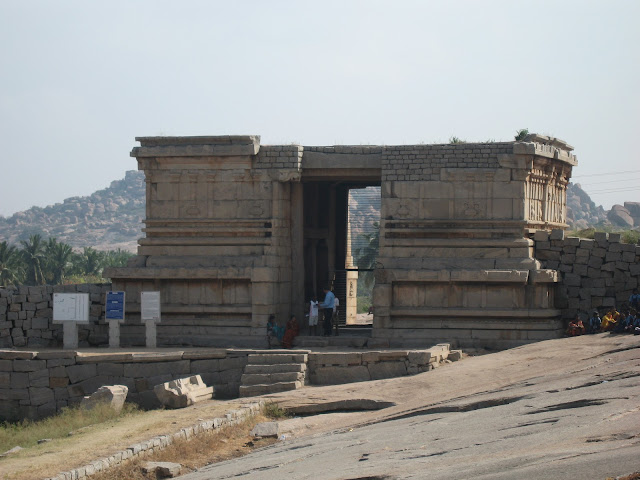Small ruined temples like this one are aplenty in and around Hampi.
Here's another beautiful temple, the Deity (perhaps Vishnu) used to be worshiped here.
The Zenana Enclosure houses the beautiful Lotus Mahal. It is said that this was like a summer palace & socializing place for the queens & other women of the royal family. This building is also known by the names Chitrangini Mahal and Kamala (lotus) Mahal. This is not built in granite, but from brick and lime mortar. It is said that the queens & other women used to come here to socialize and enjoy the cool breeze, especially during summer. The building is a 2 storied one & mostly, the royal women used to occupy the upper floor of the building. The architecture is a combination of Hindu & Islamic styles, which is perhaps why it was not destroyed during the siege. The Lotus Mahal is at some distance from the Royal Enclosure. Nobody is allowed to enter the building & we can only appreciate it by standing close to it.
There are 3 watch towers near the Lotus Mahal. Perhaps there was a fourth one too, but it no longer exists.
Very close to the Lotus Mahal is the elephants' stable & mahouts' quarters. There were 11 royal elephants which were housed in this stable. The caretakers were housed in the quarters close to the stables. Although this is shown as elephants' stables, some archaeologists believe that this could have been the king's secretariat building.
The Lakshmi - Narasimha temple is one of the star attractions of Hampi along with the stone chariot. Narasimha is one of the 10 avataara's of Lord Vishnu. In this image, Narasimha is sitting on the coils of a 7 headed snake called Adisesha in Yogic posture. The heads of the snake form the hood. On his left lap was seated His consort, Goddess Lakshmi, whose image has been destroyed in the siege. If we get inside the enclosure, we can see the remains of Lakshmi's right hand around Narasimha's waist in an embracing position. We can also notice Her finger nails and rings which are so beautifully sculpted. Since His consort has been destroyed, this image is also often called Ugra Narasimha, the aggressive form of Narasimha. Essentially, Narasimha is the God whose form is half-man half-lion. Nara means man, simha means lion. Both the hands of the Deity have been destroyed & so have both His feet. In the normal form, the right hand of Lakshmi Narasimha can be found to be in "abhaya mudra", which means being in the "reassuring posture".
Close to Narasimha temple is Badavi Linga. The story goes that, a poor lady (badavi in Kannada) wanted to contribute something memorable to the king. So, she obtained the king's permission, dug into her meager savings & got this Shiva Linga made and had it established near Narasimha. This Linga is one of the largest in the country. It stands tall at 12 feet high, the bottom 3 feet of which is always under water. The upper 9 feet is visible to devotees. Since the Linga is constantly under water, it is called Jalakantheshwara. Worship is still carried out here.
Atop the Hemakuta hill are 2 large Ganesha idols - sasivekaalu Ganesha & kadalekaalu Ganesha. Sasivekaalu means mustard seed & kadalekaalu means bengal gram. The sasivekaalu Ganesha is about 2.4 meter high. This is a monolithic Ganesha sculpted from a single huge rock.
An open pavilion has been built around the sasivekaalu Ganesha & from the inscriptions found nearby it becomes clear that the pavilion was built by a trader from Chandragiri (in present day Andhra Pradesh) in 1506 AD. The trader had this built in memory of Narasimha II (1491 AD to 1505 AD), one of the Vijayanagar kings. Saasivekaalu Ganesha from a distance...
The kadalekaalu (bengal gram) Ganesha is also a monolithic idol sculpted from a single huge boulder. This Ganesha got the name because His belly resembles a grain of bengal gram (kadalekaalu in Kannada). This Ganesha is almost double that of sasivekaalu Ganesha and stands tall at about 4.5 meter & is one of the largest sculptures in Hampi. The belly of this Ganesha has been mutilated & hence no worship is carried out. A beautiful sanctum has been built for this Ganesha. The sanctum is built with slender pillars on which have been sculpted mythological themes.
One of the entrances on the Hemakuta hill. The path thru' this entrance takes us to the kadalekaalu Ganesha.
A closeup view of kadalekaalu Ganesha.















No comments:
Post a Comment